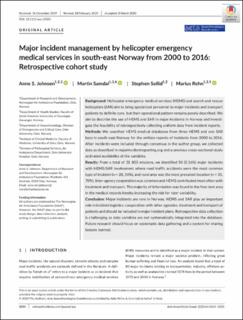| dc.contributor.author | Johnsen, Anne Siri | |
| dc.contributor.author | Samdal, Martin | |
| dc.contributor.author | Sollid, Stephen J. M. | |
| dc.contributor.author | Rehn, Marius | |
| dc.date.accessioned | 2021-03-02T12:53:58Z | |
| dc.date.available | 2021-03-02T12:53:58Z | |
| dc.date.created | 2020-10-02T15:47:41Z | |
| dc.date.issued | 2020 | |
| dc.identifier.citation | Johnsen, A.S., Samdal, M., Sollid, S.J.M., Rehn, M. (2020) Major incident management by helicopter emergency medical services in south-east Norway from 2000 to 2016: Retrospective cohort study . Acta Anaesthesiologica Scandinavica, 64 (7), 1014-1020. | en_US |
| dc.identifier.issn | 0001-5172 | |
| dc.identifier.uri | https://hdl.handle.net/11250/2731172 | |
| dc.description.abstract | Background
Helicopter emergency medical services (HEMS) and search and rescue helicopters (SAR) aim to bring specialized personnel to major incidents and transport patients to definite care, but their operational pattern remains poorly described. We aim to describe the use of HEMS and SAR in major incidents in Norway and investigate the feasibility of retrospectively collecting uniform data from incident reports.
Methods
We searched HEMS medical databases from three HEMS and one SAR base in south‐east Norway for the written reports of incidents from 2000 to 2016. After incidents were included through consensus in the author group, we collected data as described in majorincidentreporting.org and a previous cross‐sectional study and rated availability of the variables.
Results
From a total of 31 803 missions, we identified 50 (0.16%) major incidents with HEMS/SAR involvement where road traffic accidents were the most common type of incident (n = 28, 56%), and rural area was the most prevalent location (n = 35, 70%). Inter‐agency cooperation was common and HEMS contributed most often with treatment and transport. The majority of information was found in the free‐text area in the medical records hereby increasing the risk for rater variability.
Conclusion
Major incidents are rare in Norway. HEMS and SAR play an important role in incident logistics, cooperation with other agencies, treatment and transport of patients and should be included in major incident plans. Retrospective data collection is challenging as data variables are not systematically integrated into the database. Future research should focus on systematic data gathering and a system for sharing lessons learned. | en_US |
| dc.language.iso | eng | en_US |
| dc.rights | Navngivelse 4.0 Internasjonal | * |
| dc.rights.uri | http://creativecommons.org/licenses/by/4.0/deed.no | * |
| dc.subject | luftambulanse | en_US |
| dc.subject | helicopter emergency medical services | en_US |
| dc.title | Major incident management by helicopter emergency medical services in south-east Norway from 2000 to 2016: Retrospective cohort study | en_US |
| dc.type | Peer reviewed | en_US |
| dc.type | Journal article | en_US |
| dc.description.version | publishedVersion | en_US |
| dc.rights.holder | © 2020 The Authors. | en_US |
| dc.subject.nsi | VDP::Medisinske Fag: 700::Klinisk medisinske fag: 750::Traumatologi: 783 | en_US |
| dc.source.pagenumber | 1014-1020 | en_US |
| dc.source.volume | 64 | en_US |
| dc.source.journal | Acta Anaesthesiologica Scandinavica | en_US |
| dc.source.issue | 7 | en_US |
| dc.identifier.doi | 10.1111/aas.13583 | |
| dc.identifier.cristin | 1836664 | |
| cristin.ispublished | true | |
| cristin.fulltext | original | |
| cristin.qualitycode | 1 | |

